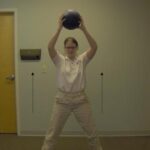Using a stability ball increases muscle definition, strength, and flexibility by targeting more than one muscle with one full range of motion. This is why it’s beneficial to incorporate a stability ball into your training program. Muscles addressed include abdominal, pelvic, back, hip, pectoral, quadriceps, triceps, and hamstrings. Taking care of your muscles will help you lose fat more efficiently, preserve or improve bone density, and avoid joint problems.
Physical therapists originally used stability balls with patients suffering from spinal injuries or neurological damages. After much success as a low impact rehabilitation tool for increasing flexibility and strength, stability balls are now also found in every gym and sports store. Everyone needs strong muscles to function properly. So, incorporate the stability ball into your training program for better overall fitness results.
The muscle group often associated with a stability ball workout is the core. This group includes the abdominal, pelvic, and back muscles. We use them everyday to walk upright and sit straight. These muscles are originally so strong that babies can often sit on their buttocks with back and legs straight out. As we age and become accustomed to slouching, these muscles become weak and saggy.
Come summer, this group is probably targeted more than any other part of the body. If you want a flat stomach and a six pack, the stability ball should definitely be part of your training. After working on your core muscles, focus on hamstring and quadriceps moves that also firm up the buttocks area. You’ll look good coming and going on the beach or at the pool.
Don’t know how to use a stability ball? Either hire a trainer for a session to help you devise a program, or seek out suggestions at the Mayo Clinic website or through magazines found online, such as Runner’s World, Fitness, Men’s Health, Women’s Health, and Self. Search for exercises based on which muscle groups you plan to target.
Still not sold on incorporating the stability ball into your training. Well, these additional benefits are sure to persuade you.
A stability ball also known as a fitness or exercise ball can be purchased online or at a store selling workout equipment for a relatively low price ranging from $8.99 to $39.99. Balls are sold with either a user friendly manual or DVD filled with tips to help you get started.
The ball does not take up much room and is easily transportable making it a breeze to stick with your routine no matter your location. It can even be sat upon at the office strengthening your core while you work.
Routines using a fitness ball can be structured to accommodate individuals with varying fitness abilities and goals. Stability ball workouts prepares muscles necessary to complete cardio routines.
Since exercise balls are light and soft, chance of injury is slim. Fitness ball training leads to balanced muscles, and therefore less likelihood of injury during other sports. Eventually, weights can be added to provide either further definition or increased bulk.
To reap these benefits, purchase a ball now. Balls are sold based on your height. The size of the ball should allow for a 90 degree angle of your legs while sitting on the ball. When purchasing a ball, there is another thing to consider. Stability balls are often crafted from a soft material called PVC (polyvinyl chloride). However, with environmental concerns on the rise and people making more conscious purchases vinyl balls are now also available. Please keep this in mind when buying your stability ball.
Now that you have a stability ball, get started by trying out the seven exercises summarized below.
Abdominal Crunches benefit your abdomen and lower back. Sit up straight on the ball with your feet flat on the ground. Place your hands either crisscrossed on your chest or resting behind your head but not pulling on your neck. Tighten your stomach muscles and lean back until you feel a full contraction. Hold this position for a few moments while remembering to breathe. Then, return to an upright sitting position.
Do the Airplane for the mid and upper back muscles with an extra benefit for the buttocks, too. Place the front of your hips on the ball with your toes touching the floor. Let your arms loosely hang in front of your ball. All at once, raise your toes into a position like an airplane tail and your arms like airplane wings. Squeeze your glutes. Hold. Then, return to the original position and repeat.
For your hips and lower back, perform the Body Tuck. Get into a position similar to the airplane except instead of resting your hips, rest your shins and assume a push up position. Roll your legs forward towards your arms until your knees are balancing on the top of the ball and your buttocks is in the air. Sit back making contact between your heels and butt. Go back to push up like position and do again.
Push Ups will work the chest and arm muscles. Place your abdomen on top of your ball. Slowly roll forward, walking on your hands, until your thighs rest atop the ball. Contract your stomach muscles until your belly button feels as if it just might touch your spine. Bend your elbows and lower down to the floor while keeping your head and neck aligned, abdominal muscles tight. Push up. Continue with the set.
Quadriceps get a workout with Wall Squats. Stand with your back against your stability ball while it rests on a wall. Roll your back along the ball into a squat position. When you roll back up, squeeze your glutes. Once you have that move mastered, try it with one leg.
Use the Body Arch similar to a bridge position for the hips, abdominal, and pectoral muscles. Rest your middle back against the ball while in a deep squat position. Stretch your arms past your head and lengthen your legs until they’re almost straight. Come back up and repeat.
Work those oft neglected hamstrings with the Curl. While on the floor, put your heels and calves on top of your exercise ball. With your arms at your sides, upper back and shoulders on the floor, and abs tight, raise your hips and lower back. Roll the ball toward your butt. To keep the ball steady, dig your heels into the top. Then, roll the ball away from you and start over.
Before long, you’ll be stronger and more flexible. Your strong muscles will help you burn more calories and fat during cardio workouts, and people will be jealous of your chiseled abs. Your body will feel good, look good, and stay strong as you age if you incorporate a stability ball into your training. So, give it a try and buy one for someone you care about.




